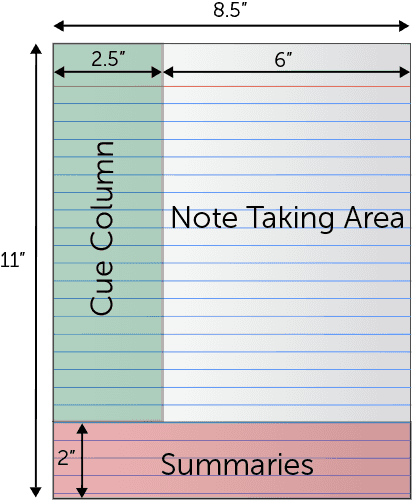Briana Dokken
Productivity ⏰
44 resourcesSee Units
Maximizing your Learning with Cornell Notes
Are you a middle school, high school, or college student trying to figure out the best way to take notes? If so, here’s one method you can try! Walter Pauk, a Cornell Professor in the 1950s, introduced this note-taking style with hopes to instill better study habits in his students. Cornell Notes have a different format than most other kinds of note-taking, and they focus on having you review and interact with your notes to better comprehend what you’re learning. Here’s how they work.
Page Setup 📚
With Cornell Notes, your page will have 3 sections; one for the regular notes you take during class, one for cues/self-test, and one for a summary. Here’s how that looks on a page:

Photo Courtesy of umfk.edu
Note Taking Area ✏️
The note-taking area is where you will take your regular class notes. Jot down important words, concepts, practice problems, questions asked, and other information that seems important from the lecture. One thing that I find helpful in this area is to make sure you have a consistent way that you organize these notes. When you review your notes, you’ll want to be able to see clearly where each section of your notes starts and stops, so make sure you have a consistent way to indicate when you start taking notes on a new topic. You could indent whenever you start a new idea, use different bullet points, or underline section titles. Use whatever works for you. Another helpful thing you can do in the note-taking area is star things that you think are important or could be on tests. Sometimes teachers will make it very clear that they want you to know a certain fact or topic, and it can help you to know what to study by putting stars next to these topics.
Cue Column ❓
The Cue or Recall Column is a place for you to write down key ideas from your notes. During class, only write notes in the Note Taking Area. Then sometime after class (ideally within a day of class), look over the notes you took. Pull out the most important definitions, concepts, and ideas, and write them down in your own words in the Cue Column near where they are in your Note Taking Area. This will be especially helpful for test review because you will be able to look back and see what is most important to know for a test. One way you can use this Cue Column to study for tests is to take the information from it and make a test review guide or a practice test. Rewriting all of the most important information in a study guide or practice test can help you remember what you will need for the test. You can also use the cue column to quiz yourself or others. Talking through important concepts with others can help you all remember the information you need for tests, so you can try using the Cue Column to study with a study group.
Summaries 📓
The bottom section of the Cornell Notes is for a summary of the notes taken in class. The summary should be short, only a couple of sentences long, going over the material you learned in the lecture. It is probably easiest to write this right after you take notes in class, while the concepts are still fresh in your brain. However, you could also do the Summary Column after writing the Cue Column and use it as a review of what you learned in class.

GIF Courtesy of Tenor.com
The 5 R’s of Note Taking 🤓
Cornell Notes can be helpful because they make you do the “5 R’s of Note Taking”. These are 5 concepts that help you learn and remember information. Regardless of how you take notes, focusing on these concepts can help you study. The 5 R’s are:
- Record: Write down important info from class in the Note Taking Area
- Reduce: Summarize the most important facts in the Cue Column
- Recite: Quiz yourself on the info in the Cue Column and recite the answers in your own words
- Reflect: Reflect on how this information relates to other topics in the class, any opinions there are in the notes, and how the information is relevant or related to other courses/subjects
- Review: Review your past notes for a little bit of time each week so you continue to remember the information
Browse Study Guides By Unit
📚Study Strategies
📓Note Taking
🤘Testing Tips

Fiveable
Resources
© 2025 Fiveable Inc. All rights reserved.